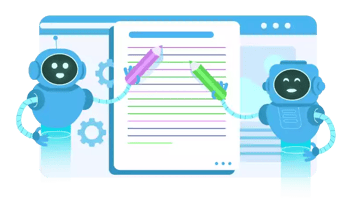Content Length: Does It Really Matter? Balancing SEO and Readability
Are you losing readers to overly long content or missing SEO opportunities with brevity? The content length dilemma impacts every digital marketer. Search engines favor depth, yet engagement demands conciseness. So, what’s the real answer? Understanding the nuances of your audience, marketing goals, and topic complexity is crucial for crafting content that ranks and resonates.
The SEO Perspective: Length and Search Engine Optimization
You've probably heard the saying: longer content translates to better SEO and improved SERP rankings. For a long time, that's been the general idea in digital marketing. The thinking was pretty straightforward: if you write more, you cover more ground, which has got to be good for your ranking, right?
Well, there's definitely some truth to it. Longer content does let you dig deeper into a topic. You can explore all those little details, bring up related points, and really give readers a comprehensive understanding. This is especially helpful for those complex subjects that need a bit more explaining–and when you're aiming for that top spot in search results, every bit of detail counts. Take HubSpot's data, for instance—they found that blog posts around 2,100 to 2,400 words tend to perform best for SEO. That's a solid chunk of content, showing search engines you're serious about covering the topic.
Now, think about how search engines like Google work. They want to give people the best answers to their questions. And if you've got a detailed, in-depth piece, you're more likely to provide those answers. So, it makes sense that Google might give a little extra love to those longer articles. It's like saying, "Hey, this content really gets into the nitty-gritty; it's worth showing to users." Plus, we've seen that longer articles, especially those over 2,000 words, tend to rank higher—it's not just a hunch; there's data to back it up.
Of course, it's not just about throwing words on a page. You've got to make sure it's relevant content and valuable content. You want to give readers something they actually care about, something that adds value. And if you can do that in a longer format, even better. Backlinko's research showed that articles with 3,000 words or more tend to get 77% more backlinks, which tells search engines your content is pretty legit.
And let's not forget keywords. Longer pieces give you more chances to naturally weave in those important terms. But remember, natural is key here. Nobody likes reading something that's just stuffed with keywords, and you can get penalized for keyword cannibalization if you're too heavy-handed. It's got to flow; it's got to make sense. You want to create content that both the search engines and your readers will appreciate.
The User Experience: Readability and Engagement
So, we've talked about how longer content can be a win for SEO, but here's the big question: are you actually turning people off by writing those super long articles? Let's face it; we've all clicked on an article, seen a wall of text, and thought, "Nope, not today."
That's where readability comes in. It's not just about getting people to click on your content; it's about getting them to stick around and read it. Readability is all about how easy your content is to digest. Think clear sentences, logical flow, and language that doesn't make people feel like they need a dictionary. If your content is a slog to get through, people will bounce, no matter how much SEO juice it has.
And here's the thing: sometimes, shorter and sweeter is the way to go. For specific audiences or certain topics, a concise, well-structured piece can be way more effective. If you're targeting a busy professional who just wants the key takeaways, a 500-word summary might be gold. Or, if you're explaining a simple concept, why drag it out to 2,000 words?
Formatting is your best friend when it comes to readability. Break up that text with headings, subheadings, bullet points, and visuals. A well-placed image or a short video can make a world of difference–it's like giving your readers little breaks as they move through the content.
Now, let's talk about short-form content versus long-form content. It's not one-size-fits-all. On platforms like X (previously Twitter) or Instagram, short and punchy is the name of the game. People are scrolling–they want quick hits. But on your blog or platforms like LinkedIn, longer, more in-depth content can really shine. It's all about knowing your audience and where they're consuming your content.
And finally, let's address the elephant in the room: keeping your readers engaged. Nobody wants to read something boring. Mix it up! Use real-life examples, throw in some data, ask questions, and keep the tone conversational. Don't be afraid to add a bit of personality. And don't forget to proofread! Nothing kills engagement faster than typos and grammatical errors. You want your readers to feel like they're having a conversation, not reading a textbook.
Factors Influencing Content Length
Marketing Goals
First off, your marketing goals play a huge role. If you're laser-focused on SEO, longer, comprehensive content is generally your best bet. Why? Because search engines love in-depth stuff. They see it as more valuable and authoritative. You're showing them you've done your homework and covered all the angles.
But maybe SEO isn't your main priority–perhaps you're trying to build brand awareness. In that case, shorter, punchier content can be more effective. Think snappy social media posts, eye-catching infographics, or short, engaging videos. You want to grab attention and make an impression, and you don't always need a novel to do that.
If you're aiming for lead generation, you'll likely need to lean towards longer content. You've got to provide enough value to convince people to give you their contact info. That means detailed guides, informative white papers, or in-depth case studies. You're essentially saying, "Here's a ton of useful stuff, and if you want even more, let's talk."
And if your goal is customer education, longer content is a must. You're teaching people something, and that often requires detailed explanations, step-by-step instructions, and plenty of examples. Think of it like a textbook—you can't cram a whole course into a tweet.
Target Audience
Next up, your target audience. Are you talking to a technical audience? They'll probably appreciate longer, more detailed content. Think developers, engineers, scientists. They want the nitty-gritty, the specs, the data. They want to know how things work, so they're likely not afraid of a few extra pages.
But if you're targeting a general audience, you might want to keep it concise. People have short attention spans and want information they can digest quickly. Think summaries, bullet points, and clear, simple language.
Topic Complexity
Then there's the topic complexity. Some topics just require more space. If you're explaining quantum physics or the intricacies of blockchain technology, you're going to need a lot of words. But if you're writing about simple tips for organizing your desk, you can probably keep it short and sweet.
Content Type
And don't forget the content type. Blog posts often thrive in that 1,500-2,000 word sweet spot. It's enough to cover a topic thoroughly without overwhelming readers. Social media posts, on the other hand, need to be brief and engaging. Think punchy headlines, eye-catching visuals, and calls to action.
Email marketing? That's a bit of a wild card–it depends on the message and the audience. A quick update? Keep it short. A detailed newsletter? You can go a bit longer. The key is to test and see what resonates with your subscribers.
Practical Guidelines and Examples
So, you're staring at a blank screen, wondering how many words to type. Here's a quick rundown:
-
For general branding and quick informational pieces, aim for 500-1,000 words. Think: short blog posts, quick tips, and "listicle" style articles.
-
If you're diving into in-depth blog posts and articles, 1,500-2,000 words is a good target.
-
For those really complex topics or those super detailed guides? Go big—2,000 words and up.
Now, let's look at some examples. For long-form content done right, check out in-depth guides from software companies explaining complex features. For short-form wins, look at how fast-food chains use short, snappy social media posts to announce limited-time offers.
Data and statistics? They're your secret weapon. You build trust and credibility when you back up your claims with numbers. It's like saying, "Hey, I'm not just making this up; here's the proof."
And how do you figure out what length works best for your audience? Analytics! Dive into your website data. See how long people are staying on your pages. Check out your bounce rates. This will give you clues about what your audience prefers.
Finally, keep it interesting. Use real-life examples, tell stories, and don't be afraid to add a bit of personality. Break up the text with visuals, use subheadings, and keep the language engaging. And again, proofread! Nothing kills engagement faster than typos and grammatical errors.
Finding Your Content Sweet Spot
It's time to stop throwing content at the wall and hoping something sticks. The truth is, mastering content length is about strategy, not guesswork. It's about understanding your audience, your goals, and the intricate dance between SEO and reader engagement. In doing so, you can create content that ranks and resonates deeply with your audience. Once you find the right length, you'll be on your way to experiencing lower bounce rates, higher engagement, and a noticeable increase in conversions.
Are you ready to make a real impact with your content marketing? Aspiration Marketing offers expert guidance and done-for-you services to help you achieve your goals. Let's create content that truly matters.
This content is also available in:
- German: Inhaltlänge und SEO: Die Balance zwischen Lesbarkeit und Ranking
- Spanish: Longitud del Contenido: ¿Cómo Equilibrar SEO y Legibilidad?
- French: SEO vs Lisibilité: trouver la longueur idéale pour votre contenu
- Italian: Lunghezza dei Contenuti: Trovare l'Equilibrio tra SEO e Leggibilità
- Romanian: Lungimea conținutului: Cum să echilibrezi SEO și lizibilitatea
- Chinese: 内容长度:它真的重要吗?平衡搜索引擎优化与可读性










Leave a Comment